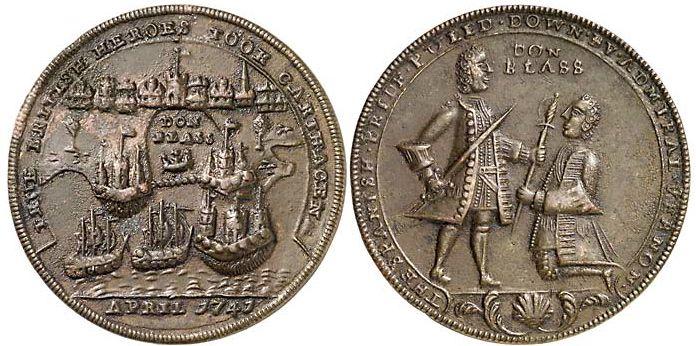Vernon's medals: the false English victory over Blas de Lezo
One of the most unique conflicts in the history of Spain was precisely the battle of Cartagena de Indias (1741), in which Great Britain wanted to go down the list by selling the bear's skin without having hunted it. So much so, that the English admiral Edward Vernon had a series of coins minted so that the news of its conquest to Spain would begin to spread, given that, according to him, with only six warships he could reach it.
Finally, and despite his more than 130 ships and 38,000 men (it became one of the largest naval deployments ever seen until the Normandy landings), our great Admiral Blas de Lezo y Olavarrieta defeated them, becoming a one of the greatest military feats of Spain in the lands of America.
It is said that in the middle of the war and Vernon believing that with his greater force the Spanish armada would be beaten, and more taking into account that they did not exceed 1,000 men, he sent a ship to England with the few Spanish prisoners anticipating a safe and imminent occupation, in which Cartagena de Indias became the capital of New Spain.
And this is how the astute Vernon lost his diplomacy, although not his coins, because in the year 2000 and from the donation of an individual and an antique dealer a total of thirty-nine of them arrived at the Naval Museum of Madrid. those medals.
How to Make a Chore Chart That Won't Be Ignored https://t.co/zLnPsDxu8g
— Fatherly Wed Sep 11 16:20:42 +0000 2019
Vernon's medals in the Naval Museum of Madrid

Among the most curious pieces in the collection, one stands out that bears an inscription in English that says “The pride of Spain humiliated by Admiral Vernon”, together with the image of two engraved figures. One identified as Vernon himself, who appears upright and victorious, and the other, imploring and kneeling, alluding to Blas de Lezo. On the reverse, another legend announces "A true British hero, he took Cartagena in April 1741."
Now, he, so vain and arrogant, did not take into account two big errors in his coinage, the first, obviously, is that Vernon had to retire without fulfilling his long-awaited goal, and the second, is that Blas de Lezo as he appears depicted, never ever had he been able to prostrate himself, or have held out his hand, or looked from below, due to the loss of one of his legs at the age of 17 in the combat of Vélez (1704), a eye, just three years later in the siege of Toulon, and his right arm in another of the many battles he led throughout his life.
In general, explains Carmen Lopéz Calderón, curator of the Naval Museum, “the coins are not of very good quality, since they are minted in a Pinchbeck alloy (zinc and copper), which, although in its day could be confused with the gold, the passage of time has given it a dull patina, nor are they well engraved, as they were the first coins whose function was none other than to spread the news among the people”.
Likewise, and in almost all the setbacks, most come to illustrate both Vernon's fleet, in some with the image of the six ships attesting to the boastfulness of the English sailor, and the fortress of Cartagena de Indias.









1612